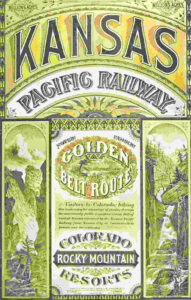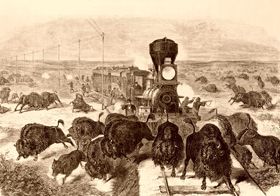The Kansas Pacific Railway was first established in 1855 as the Leavenworth, Pawnee, and Western Railroad. It was later reorganized in 1863 as the Union Pacific Eastern Division. Authorized by the United States Congress as part of the Pacific Railway Act, its mission was to create a second southerly branch of the transcontinental railroad alongside the Union Pacific Railroad.
The railroad originally intended to build a line west from Kansas City, Kansas, to Fort Riley, Kansas, then north to join the Union Pacific mainline at Fort Kearny in Nebraska. The construction of the line was partly motivated by the U.S. government’s desire to extend transportation routes into Kansas, which had been the scene of the ongoing conflict between Union and Confederate sympathizers during the Bleeding Kansas days before the start of the Civil War.
The company began construction on its mainline westward from Kansas City in September 1863, and by the following year, the first 40 miles of the line to Lawrence, Kansas, were in operation. By the fall of 1866, the line had reached Junction City and, in 1867, Salina.
In March 1869, the name was officially changed to the Kansas Pacific Railway. By the 1870s, it operated many of the long-distance lines in Kansas and soon extended the national railway network westward across that state and into Colorado. The line opened up the settlement of the central Great Plains, and its link from Kansas City, Missouri, to Denver, Colorado, provided the last link in the coast-to-coast railway network in 1870. The railroad was consolidated with the Union Pacific in 1880, but its mainline remains integral to today’s Union Pacific Railroad network.
© Kathy Alexander/Legends of America, updated April 2024.
Also See:
A Century of Railroad Building


